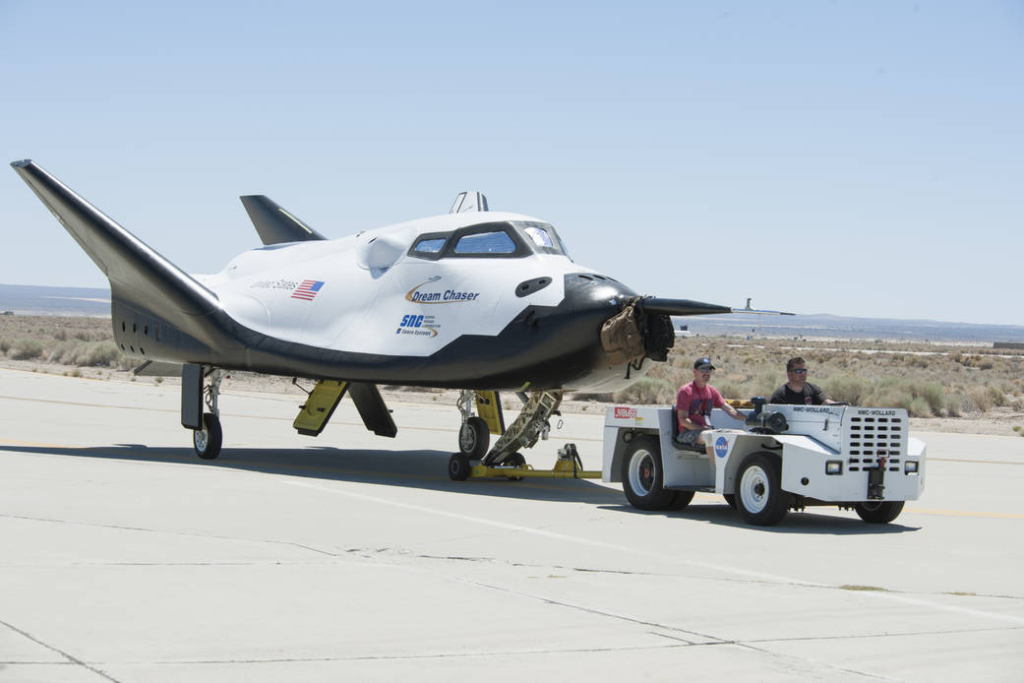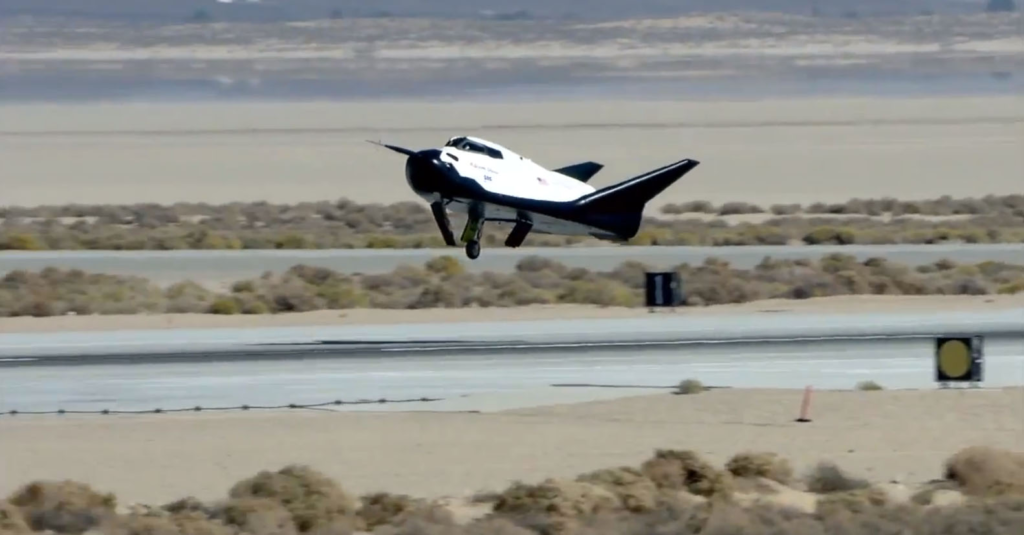
Testing Dream Chaser By Dropping It Thousands of Feet High
Not long from now Dream Chaser Tenacity is set to lift off for the first time and attempt to dock with the International Space Station, before returning safely to the surface for a gentle landing. Currently, this first SNC-DEMO 1 mission is still scheduled for the third quarter of this year. While this progress and launch proximity is exciting, in reality, Sierra Space and SNC have been working on this spaceplane for decades now.
Within this long period of development, manufacturing, and testing, two free-flight drop tests were completed with varying results. Here the company lifted a Dream Chaser test article over 10,000 feet high before dropping it. This simulated similar aerodynamic environments expected shortly after reentry. An important step to ensure that once Dream Chaser is back within Earth’s atmosphere, it can be accurately controlled for a safe runway landing.
The first of these tests was in 2013 and only provided partially successful results after a landing gear issue forced a not so soft landing. Years later the company tried again and was satisfied with the results to the point where it marked the last significant flight test of this spaceplane. Here I will go more in-depth into these two very unique tests, the successful and not-so-successful landing, how they apply to Tenacity’s upcoming launch, and more.
Free Flight Drop Tests

Long before Dream Chaser Tenacity was taking shape, Sierra Nevada Corporation built spaceplane test articles that were not built for space, but rather various atmospheric tests. The first was in 2013 which was not 100 percent successful. Specifically, on October 26th, 2013, SNC performed its first free-flight approach-and-landing test of the Dream Chaser spacecraft.
Here, the vehicle successfully released from its carrier aircraft, an Erickson Air-Crane helicopter, as planned at approximately 11:10 a.m. Pacific Standard Time. Following release, the Dream Chaser spacecraft automated flight control system gently steered the vehicle to its intended glide slope. The vehicle adhered to the design flight trajectory throughout the flight profile. Less than a minute later, Dream Chaser smoothly flared and then touched down on Edwards Air Force Base’s Runway on the centerline. However, SNC said in a report that “While there was an anomaly with the left landing gear deployment, the high-quality flight and telemetry data throughout all phases of the approach-and-landing test will allow SNC teams to continue to refine their spacecraft design. SNC and NASA Dryden are currently reviewing the data. As with any space flight test program, there will be anomalies that we can learn from, allowing us to improve our vehicle and accelerate our rate of progress.”
In the video, you can see everything up until the point of contact with the runway. Here, two of the three landing gears deployed with one having issues. Reports highlight that this caused the spacecraft to veer off the runway right after touchdown and damage the test article. Unfortunately, SNC cuts the video footage of this event right before the spaceplane lands. They also commented that “the deployment issue was a mechanical failure, was not software related, and is not expected to be a serious setback for the project.”
Years later in late 2017, the company tried again this time with more promising results. On November 11th, 2017, Dream Chaser was dropped once again this time from 12,400 feet in the air. This time, however, the spaceplane glided to a successful landing at NASA’s Armstrong Flight Research Center located on Edwards Air Force Base in California. At the time of this test, NASA was very interested in this spacecraft for possible future crew operations. Steve Stich, deputy manager of NASA’s Commercial Crew Program commented, “It is very exciting that Sierra Nevada Corp successfully completed this important free-flight test. The Dream Chaser team has done an amazing job preparing for and executing this test, and the Commercial Crew Program has been with them along the way. The flight computers and avionics systems are the same as the orbital vehicle so this test will pave the way for future landings for the International Space Station missions.”
Around this time period, the tests were helping Sierra Nevada Corp. validate the aerodynamic properties, flight software, and control system performance of the Dream Chaser under the Commercial Crew Integrated Capability Contract, or CCiCap, for commercial crew. The free flight and landing were similar to five approach and landing flight tests of the space shuttle in 1977. The space shuttle Enterprise was released from a NASA 747 shuttle carrier aircraft, gliding to a piloted landing at Edwards. One of many similarities these spaceplanes share.
Tenacity’s Progress

Now that we know more about some of Dream Chaser’s core flight tests, we can take a closer look at Tenacity’s progress and the future of spaceplanes within the industry. While Sierra Space for the most part has been quiet regarding Tenacity’s progress, they still have released various updates on the vehicle. Only hours ago they tweeted mentioning, “As the first Dream Chaser® spaceplane enters its final production phase, Sierra Space has made a key executive hire with veteran aerospace leader Steve Berroth joining the leadership team as Senior Vice President and General Manager.” Included was a short report that was quoted saying, “The first Dream Chaser, Tenacity, is nearing completion and will subsequently ship to NASA’s Neil A. Armstrong Test Facility in Cleveland, Ohio, for final space environmental testing ahead of its first mission to the ISS later this year. With so many different pieces and even companies working together on Tenacity’s first launch, a lot can push it back. Not to mention the fact that first ever launches of spacecraft or rockets often take extra time. While the third quarter was the target date, it’s possible that it gets pushed back as Vulcan continues to prepare and Tenacity is completed.
For months now Dream Chaser Tenacity has been undergoing thermal tile application. In total, thousands of these tiles will cover the spaceplane to ensure it can withstand the harsh temperatures realized during reentry. While Sierra Space makes it clear that a host of improvements have been made to this thermal system compared to the Shuttle, it still is a tedious and complex process that takes time. Based on the fact that the company has not shared any details or news that this part of the build is completed, we can assume they are still working to apply each tile.
In addition to Tenacity, the company is also working on a Shooting Star module as well. Back in 2019, it was announced that an expendable Shooting Star cargo module would be part of the Dream Chaser cargo system for CRS-2 flights. The module is a 15-foot (4.6 m) long attachment to Dream Chaser that will allow the spacecraft to carry an additional 10,000 pounds (4,500 kg) of pressurized and unpressurized cargo to ISS. The module supports disposal of unwanted cargo by burning up upon re-entry. In addition to carrying cargo, the Shooting Star module includes solar panels that supply up to 6 kW of electrical power. It also supplies active and passive thermal management; provides Dream Chaser translation & rotation capability via six mounted thrusters; and supports berthing or docking (in different configurations) to the ISS. Access from ISS to Dream Chaser will involve crew passing through Shooting Star (which supports a shirt-sleeve environment) and through a hatch that separates Shooting Star from Dream Chaser. Sierra Nevada says the module is capable of additional types of missions in LEO or to cis-lunar destinations; they have developed a free-flying variant with additional capabilities.
As far as progress, the module has had a similar manufacturing time as the spaceplane. Back in 2020, SNC tweeted mentioning, “The Shooting Star transport vehicle was delivered to us from Applied Composites San Diego. While SNC designed it, they built it for us. It took about five years of designing, building & testing for Shooting Star to look like how it does today.” This included an image of both this Shooting Star module and a Dream Chaser in early development. Its important to point out that because Shooting Star is not reuable, Sierra Space will need to make quite a lot of them for each Dream Chaser missions that requires it. This should help the development time as they get more experience building and testing the module.
Shooting Star adds a service for NASA to send additional critical science, food, and cargo to the space station. Dream Chaser by itself has very limited cargo and general payload capacity. Crews can access the Shooting Star via the aft hatch, berthing to the space station. Traveling through the Shooting Star takes them to the forward portion where they can open the hatch and gain access to the Dream Chaser. When attached to the space station, Shooting Star provides a normal cabin environment for astronauts to work, and a prime location for cargo to be removed and placed onto the station after berthing. It also provides a host of disposal services which are very valuable when making consistent mission to the ISS.
Conclusion
Sierra Space is getting very close to the first launch of Dream Chaser Tenacity. In the last decade we have watched a host of different tests including two separate free flight tests. The first was not entirely successful but the second gave the company the confidence to move on. If Sierra Space wants to be ready in time for the third quarter of this year, they will need to have all hands on deck. We will have to wait and see how it progresses and the impact it has on the space industry.